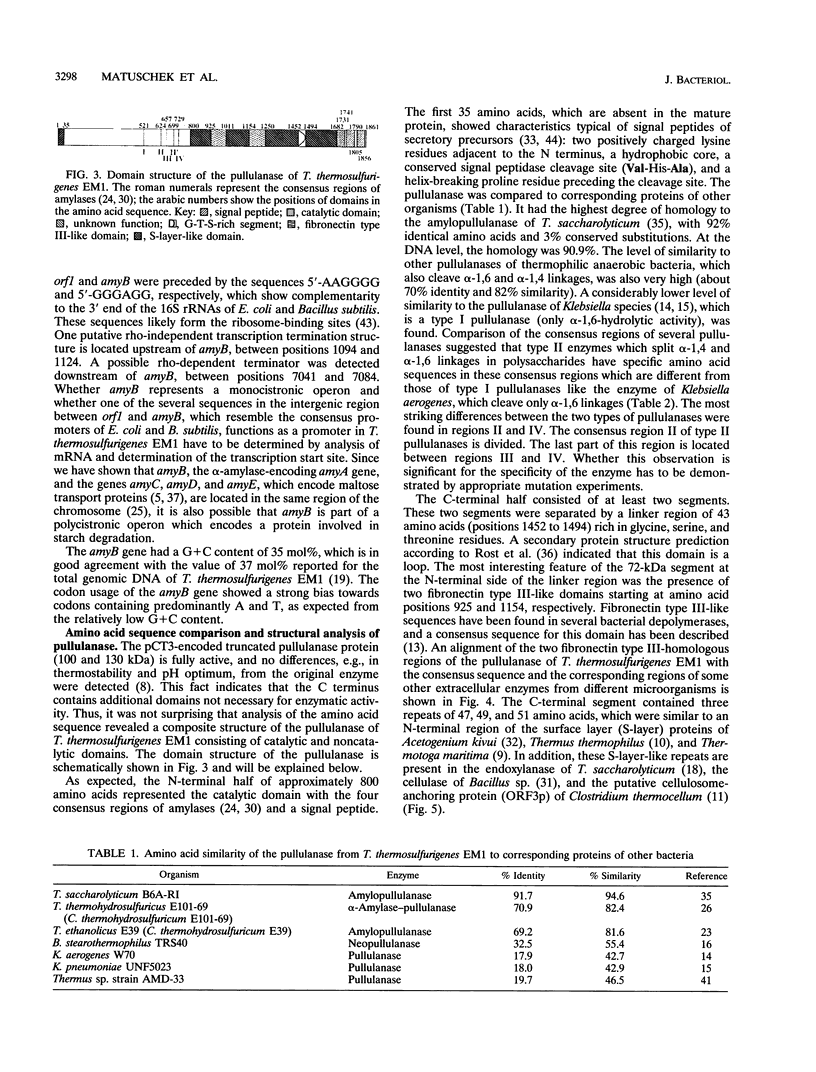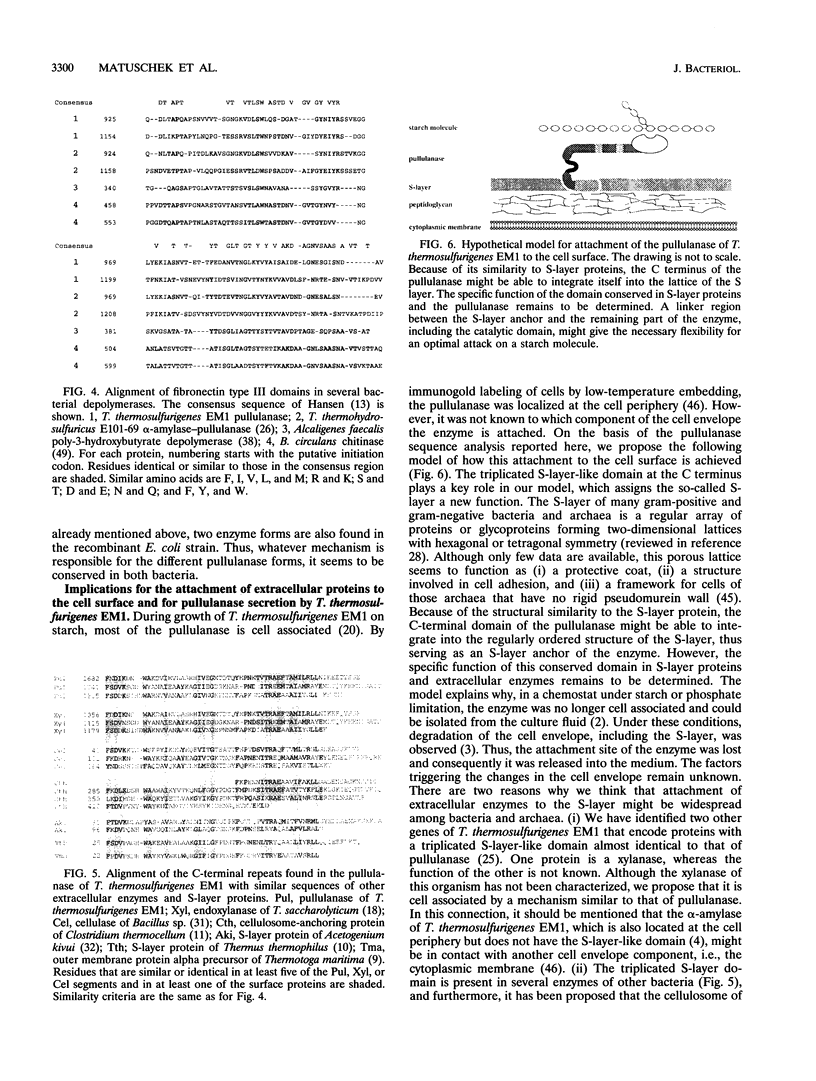Abstract
The complete pullulanase gene (amyB) from Thermoanaerobacterium thermosulfurigenes EM1 was cloned in Escherichia coli, and the nucleotide sequence was determined. The reading frame of amyB consisted of 5,586 bp encoding an exceptionally large enzyme of 205,991 Da. Sequence analysis revealed a composite structure of the pullulanase consisting of catalytic and noncatalytic domains. The N-terminal half of the protein contained a leader peptide of 35 amino acid residues and the catalytic domain, which included the four consensus regions of amylases. Comparison of the consensus regions of several pullulanases suggested that enzymes like pullulanase type II from T. thermosulfurigenes EM1 which hydrolyze alpha-1,4- and alpha-1,6-glycosidic linkages have specific amino acid sequences in the consensus regions. These are different from those of pullulanases type I which only cleave alpha-1,6 linkages. The C-terminal half, which is not necessary for enzymatic function, consisted of at least two different segments. One segment of about 70 kDa contained two copies of a fibronectin type III-like domain and was followed by a linker region rich in glycine, serine, and threonine residues. At the C terminus, we found three repeats of about 50 amino acids which are also present at the N-termini of surface layer (S-layer) proteins of, e.g., Thermus thermophilus and Acetogenium kivui. Since the pullulanase of T. thermosulfurigenes EM1 is known to be cell bound, our results suggest that this segment serves as an S-layer anchor to keep the pullulanase attached to the cell surface. Thus, a general model for the attachment of extracellular enzymes to the cell surface is proposed which assigns the S-layer a new function and might be widespread among bacteria with S-layers. The triplicated S-layer-like segment is present in several enzymes of different bacteria. Upstream of amyB, another open reading frame, coding for a hypothetical protein of 35.6 kDa, was identified. No significant similarity to other sequences available in DNA and protein data bases was found.
Full text
PDF







Images in this article
Selected References
These references are in PubMed. This may not be the complete list of references from this article.
- Antranikian G., Herzberg C., Gottschalk G. Production of Thermostable alpha-Amylase, Pullulanase, and alpha-Glucosidase in Continuous Culture by a New Clostridium Isolate. Appl Environ Microbiol. 1987 Jul;53(7):1668–1673. doi: 10.1128/aem.53.7.1668-1673.1987. [DOI] [PMC free article] [PubMed] [Google Scholar]
- Bahl H., Burchhardt G., Spreinat A., Haeckel K., Wienecke A., Schmidt B., Antranikian G. alpha-Amylase of Clostridium thermosulfurogenes EM1: nucleotide sequence of the gene, processing of the enzyme, and comparison of other alpha-amylases. Appl Environ Microbiol. 1991 May;57(5):1554–1559. doi: 10.1128/aem.57.5.1554-1559.1991. [DOI] [PMC free article] [PubMed] [Google Scholar]
- Bahl H., Burchhardt G., Wienecke A. Nucleotide sequence of two Clostridium thermosulfurogenes EM1 genes homologous to Escherichia coli genes encoding integral membrane components of binding protein-dependent transport systems. FEMS Microbiol Lett. 1991 Jun 1;65(1):83–87. doi: 10.1016/0378-1097(91)90476-q. [DOI] [PubMed] [Google Scholar]
- Birnboim H. C., Doly J. A rapid alkaline extraction procedure for screening recombinant plasmid DNA. Nucleic Acids Res. 1979 Nov 24;7(6):1513–1523. doi: 10.1093/nar/7.6.1513. [DOI] [PMC free article] [PubMed] [Google Scholar]
- Engel A. M., Cejka Z., Lupas A., Lottspeich F., Baumeister W. Isolation and cloning of Omp alpha, a coiled-coil protein spanning the periplasmic space of the ancestral eubacterium Thermotoga maritima. EMBO J. 1992 Dec;11(12):4369–4378. doi: 10.1002/j.1460-2075.1992.tb05537.x. [DOI] [PMC free article] [PubMed] [Google Scholar]
- Faraldo M. M., de Pedro M. A., Berenguer J. Sequence of the S-layer gene of Thermus thermophilus HB8 and functionality of its promoter in Escherichia coli. J Bacteriol. 1992 Nov;174(22):7458–7462. doi: 10.1128/jb.174.22.7458-7462.1992. [DOI] [PMC free article] [PubMed] [Google Scholar]
- Fujino T., Béguin P., Aubert J. P. Organization of a Clostridium thermocellum gene cluster encoding the cellulosomal scaffolding protein CipA and a protein possibly involved in attachment of the cellulosome to the cell surface. J Bacteriol. 1993 Apr;175(7):1891–1899. doi: 10.1128/jb.175.7.1891-1899.1993. [DOI] [PMC free article] [PubMed] [Google Scholar]
- Grunstein M., Wallis J. Colony hybridization. Methods Enzymol. 1979;68:379–389. doi: 10.1016/0076-6879(79)68027-8. [DOI] [PubMed] [Google Scholar]
- Hansen C. K. Fibronectin type III-like sequences and a new domain type in prokaryotic depolymerases with insoluble substrates. FEBS Lett. 1992 Jun 29;305(2):91–96. doi: 10.1016/0014-5793(92)80871-d. [DOI] [PubMed] [Google Scholar]
- Katsuragi N., Takizawa N., Murooka Y. Entire nucleotide sequence of the pullulanase gene of Klebsiella aerogenes W70. J Bacteriol. 1987 May;169(5):2301–2306. doi: 10.1128/jb.169.5.2301-2306.1987. [DOI] [PMC free article] [PubMed] [Google Scholar]
- Kornacker M. G., Pugsley A. P. Molecular characterization of pulA and its product, pullulanase, a secreted enzyme of Klebsiella pneumoniae UNF5023. Mol Microbiol. 1990 Jan;4(1):73–85. doi: 10.1111/j.1365-2958.1990.tb02016.x. [DOI] [PubMed] [Google Scholar]
- Kuriki T., Imanaka T. Nucleotide sequence of the neopullulanase gene from Bacillus stearothermophilus. J Gen Microbiol. 1989 Jun;135(6):1521–1528. doi: 10.1099/00221287-135-6-1521. [DOI] [PubMed] [Google Scholar]
- Lee Y. E., Lowe S. E., Henrissat B., Zeikus J. G. Characterization of the active site and thermostability regions of endoxylanase from Thermoanaerobacterium saccharolyticum B6A-RI. J Bacteriol. 1993 Sep;175(18):5890–5898. doi: 10.1128/jb.175.18.5890-5898.1993. [DOI] [PMC free article] [PubMed] [Google Scholar]
- Madi E., Antranikian G., Ohmiya K., Gottschalk G. Thermostable amylolytic enzymes from a new clostridium isolate. Appl Environ Microbiol. 1987 Jul;53(7):1661–1667. doi: 10.1128/aem.53.7.1661-1667.1987. [DOI] [PMC free article] [PubMed] [Google Scholar]
- Marck C. 'DNA Strider': a 'C' program for the fast analysis of DNA and protein sequences on the Apple Macintosh family of computers. Nucleic Acids Res. 1988 Mar 11;16(5):1829–1836. doi: 10.1093/nar/16.5.1829. [DOI] [PMC free article] [PubMed] [Google Scholar]
- Mathupala S., Saha B. C., Zeikus J. G. Substrate competition and specificity at the active site of amylopullulanase from Clostridium thermohydrosulfuricum. Biochem Biophys Res Commun. 1990 Jan 15;166(1):126–132. doi: 10.1016/0006-291x(90)91920-n. [DOI] [PubMed] [Google Scholar]
- Matsuura Y., Kusunoki M., Harada W., Kakudo M. Structure and possible catalytic residues of Taka-amylase A. J Biochem. 1984 Mar;95(3):697–702. doi: 10.1093/oxfordjournals.jbchem.a134659. [DOI] [PubMed] [Google Scholar]
- Melasniemi H., Paloheimo M., Hemiö L. Nucleotide sequence of the alpha-amylase-pullulanase gene from Clostridium thermohydrosulfuricum. J Gen Microbiol. 1990 Mar;136(3):447–454. doi: 10.1099/00221287-136-3-447. [DOI] [PubMed] [Google Scholar]
- Messner P., Sleytr U. B. Bacterial surface layer glycoproteins. Glycobiology. 1991 Dec;1(6):545–551. doi: 10.1093/glycob/1.6.545. [DOI] [PubMed] [Google Scholar]
- Messner P., Sleytr U. B. Crystalline bacterial cell-surface layers. Adv Microb Physiol. 1992;33:213–275. doi: 10.1016/s0065-2911(08)60218-0. [DOI] [PubMed] [Google Scholar]
- Ozaki K., Shikata S., Kawai S., Ito S., Okamoto K. Molecular cloning and nucleotide sequence of a gene for alkaline cellulase from Bacillus sp. KSM-635. J Gen Microbiol. 1990 Jul;136(7):1327–1334. doi: 10.1099/00221287-136-7-1327. [DOI] [PubMed] [Google Scholar]
- Peters J., Peters M., Lottspeich F., Baumeister W. S-layer protein gene of Acetogenium kivui: cloning and expression in Escherichia coli and determination of the nucleotide sequence. J Bacteriol. 1989 Nov;171(11):6307–6315. doi: 10.1128/jb.171.11.6307-6315.1989. [DOI] [PMC free article] [PubMed] [Google Scholar]
- Pugsley A. P., Chapon C., Schwartz M. Extracellular pullulanase of Klebsiella pneumoniae is a lipoprotein. J Bacteriol. 1986 Jun;166(3):1083–1088. doi: 10.1128/jb.166.3.1083-1088.1986. [DOI] [PMC free article] [PubMed] [Google Scholar]
- Pugsley A. P. The complete general secretory pathway in gram-negative bacteria. Microbiol Rev. 1993 Mar;57(1):50–108. doi: 10.1128/mr.57.1.50-108.1993. [DOI] [PMC free article] [PubMed] [Google Scholar]
- Ramesh M. V., Podkovyrov S. M., Lowe S. E., Zeikus J. G. Cloning and sequencing of the Thermoanaerobacterium saccharolyticum B6A-RI apu gene and purification and characterization of the amylopullulanase from Escherichia coli. Appl Environ Microbiol. 1994 Jan;60(1):94–101. doi: 10.1128/aem.60.1.94-101.1994. [DOI] [PMC free article] [PubMed] [Google Scholar]
- Rost B., Schneider R., Sander C. Progress in protein structure prediction? Trends Biochem Sci. 1993 Apr;18(4):120–123. doi: 10.1016/0968-0004(93)90017-h. [DOI] [PubMed] [Google Scholar]
- Saito T., Suzuki K., Yamamoto J., Fukui T., Miwa K., Tomita K., Nakanishi S., Odani S., Suzuki J., Ishikawa K. Cloning, nucleotide sequence, and expression in Escherichia coli of the gene for poly(3-hydroxybutyrate) depolymerase from Alcaligenes faecalis. J Bacteriol. 1989 Jan;171(1):184–189. doi: 10.1128/jb.171.1.184-189.1989. [DOI] [PMC free article] [PubMed] [Google Scholar]
- Sanger F., Nicklen S., Coulson A. R. DNA sequencing with chain-terminating inhibitors. Proc Natl Acad Sci U S A. 1977 Dec;74(12):5463–5467. doi: 10.1073/pnas.74.12.5463. [DOI] [PMC free article] [PubMed] [Google Scholar]
- Schneewind O., Mihaylova-Petkov D., Model P. Cell wall sorting signals in surface proteins of gram-positive bacteria. EMBO J. 1993 Dec;12(12):4803–4811. doi: 10.1002/j.1460-2075.1993.tb06169.x. [DOI] [PMC free article] [PubMed] [Google Scholar]
- Shine J., Dalgarno L. The 3'-terminal sequence of Escherichia coli 16S ribosomal RNA: complementarity to nonsense triplets and ribosome binding sites. Proc Natl Acad Sci U S A. 1974 Apr;71(4):1342–1346. doi: 10.1073/pnas.71.4.1342. [DOI] [PMC free article] [PubMed] [Google Scholar]
- Simonen M., Palva I. Protein secretion in Bacillus species. Microbiol Rev. 1993 Mar;57(1):109–137. doi: 10.1128/mr.57.1.109-137.1993. [DOI] [PMC free article] [PubMed] [Google Scholar]
- Specka U., Spreinat A., Antranikian G., Mayer F. Immunocytochemical Identification and Localization of Active and Inactive alpha-Amylase and Pullulanase in Cells of Clostridium thermosulfurogenes EM1. Appl Environ Microbiol. 1991 Apr;57(4):1062–1069. doi: 10.1128/aem.57.4.1062-1069.1991. [DOI] [PMC free article] [PubMed] [Google Scholar]
- Watanabe T., Suzuki K., Oyanagi W., Ohnishi K., Tanaka H. Gene cloning of chitinase A1 from Bacillus circulans WL-12 revealed its evolutionary relationship to Serratia chitinase and to the type III homology units of fibronectin. J Biol Chem. 1990 Sep 15;265(26):15659–15665. [PubMed] [Google Scholar]
- Yanisch-Perron C., Vieira J., Messing J. Improved M13 phage cloning vectors and host strains: nucleotide sequences of the M13mp18 and pUC19 vectors. Gene. 1985;33(1):103–119. doi: 10.1016/0378-1119(85)90120-9. [DOI] [PubMed] [Google Scholar]






